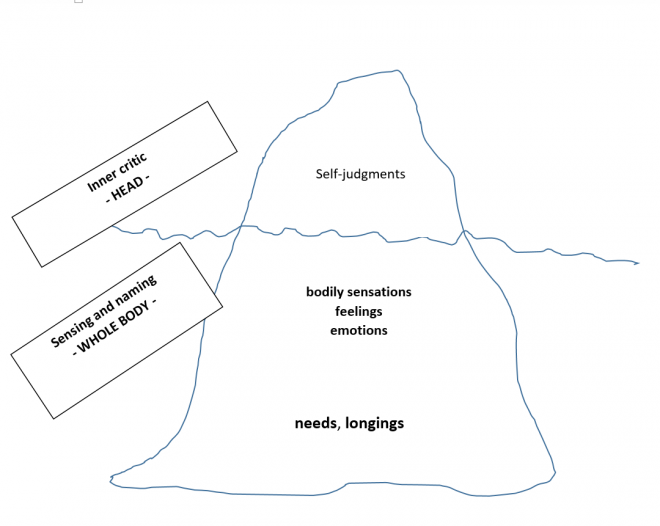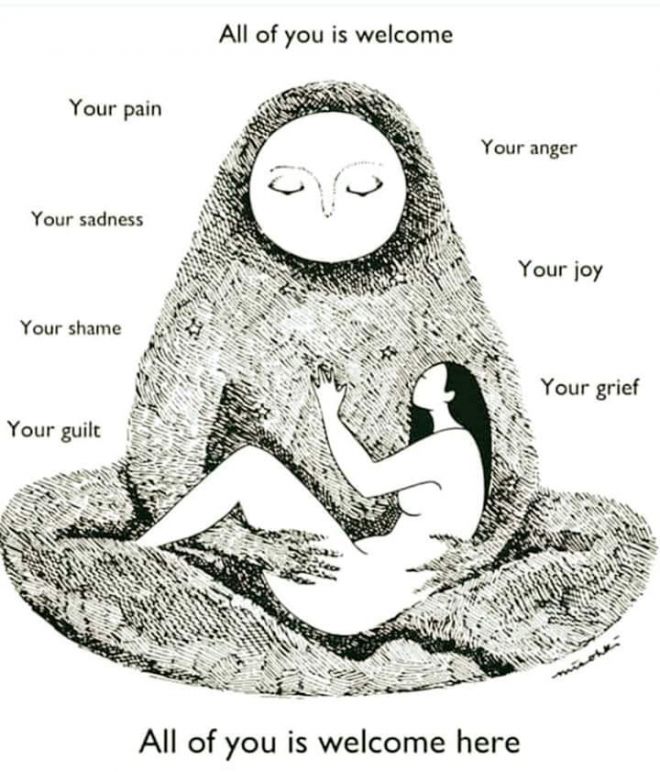Alchemy for crisis times: the inner critic as an ally
Staying at home, we get to talk with ourselves more than ever. The bigger the crisis, the more toxic our self-talk may get; affecting not just the current well-being, but also our future options. What to do?
My promise here: no affirmations, or fake positivity. I’ll talk about authenticity that reconnects rather than alienates.
What are your first words to yourself in the morning? Is it wondering what gifts the day may bring; or joy at hearing the birds sing; gratitude for being alive on this Lover Earth ...
Or is it more like: ‘Uff, another isolation day ... how am I going to cope? I’m such a terrible mother-turned-teacher to these undisciplined kids. I should get up, and get productive – to ensure I have job/income, but all I do is move from one aimless activity to another. And, oh, my attention span is down to three seconds ... good old times when I wasn’t as addicted to the news, or the social media!’
If you intentionally observe your self-talk, you may realise that it is harsher than most ‘attacks’ you receive from the outside. Which is great news, as you do hold a leverage point to change it – if you choose so.
From my experience: pausing to observe the effects that judgmental self-talk has on me, I perceive slight pain; as if I am being hit by an arrow. An arrow that, ironically, comes from myself; even if it’s triggered by the events or people around me.
Zooming in on my experience I notice my body shrinking, my worldview narrowing, and my possibilities for the future decrease.
In this piece, I am focusing on the unhealthy talk about oneself (not about the others; though similar principles apply). Noticing and transmuting it into healthier version is a huge service not only to the self, but to everyone around; and to the world in which we are all connected,
Here’s a partial menu to recognise unhealthy self-talk:
1) Labelling myself: You’re such a loser / terrible parent...
2) Comparisons: She has a family, manages a community NGO, has a gorgeous body ... while I’m nearing 40, and haven’t done anything.
3) Victimising: I am insecure because I come from an underprivileged family.
4) Punishing: If I eat any sweets today, then I’ll have to fast tomorrow. I don’t deserve a good partner because I’m so stupid. I must be kind, or else they won’t like me.
5) Demands: I have to stick to my new year’s resolutions or I’ll never achieve anything.
6) Shame and blame: It’s all my fault. I should have seen it coming, and had acted beforehand.
7) Seeing unwanted behaviours as permanent: I’ll never learn Spanish. I always nag at my spouse. People really cannot rely on me ever.
8) Black-and-white thinking: I’m too young; everyone is older here. I’m too old; this hi tech stuff is only for young generations.
9) Catastrophising: Well, this is just a beginning. This virus thing will see us all jobless, homeless, fighting for survival...
10) Deeper limiting beliefs about who I am: I’m not good enough. I’m not worthy. I’m too much. I’ don’t deserve. I don’t belong anywhere.
Are these 'menu items' have one thing in common: they are negative judgments about the self.
A self-judgment is a form of self-attack. When attacked, we humans typically deal with it in three ways:
- Freeze: capacity to perceive, feel and act is stopped; or hugely diminished.
- Flight: refocus attention to something pleasant; diminish its impact by consoling, or comparing with larger challenges in life ...
- Fight: find counter evidence: examples when the judgment isn’t true; make flattering comparisons (others fare even worse!); attack oneself for having negative thoughts ...
While all these strategies might bring temporary relief, they do not bring change in the longer term. They in fact might create more judgments about oneself.
Any judgment contains a lot of passion, and thus energy.
How could the pain and passion hidden in the judgment be honoured, and mobilised for healing?
To me, judgments are messengers that reconnect me to my deeper longing(s) in the given moment.
Iceberg model of inner dialogue

The shift from judgments to longings can happen on several levels:
A. Rationally excavating the longing hidden underneath (= turning the judgment to its opposite):
- ‘I’m not good enough’ → I so need acceptance and self-acceptance
- ‘I have nothing interesting to say, everyone will laugh at my remarks in the class.’ → I so long for self-trust, acceptance by others, relaxed and fun classroom ...
- ‘I have to stick to my new year’s plan.’ →Self-acceptance; productivity, progress are important to me.
B. An embodied experience:
(1) Notice sensations in the body – tightness, trembling, shakenness, stuckness, numbness...
(2) Warmly embrace and name the emotion connected with the sensation: fear; sadness; rage; loneliness; despair; grief; helplessness ...
(3) Identify and name the need underneath: what am I really, really longing for right now? What is a deeper need that is important to me - and not fulfilled in this situation
Practice welcoming, allowing self-talk:
- ‘I’m not good enough’ → ‘Marjeta, are you feeling exasperated, because you would so like to be at peace with who you are, how you show up, what you offer to the world?
- ‘I have nothing interesting to say, everyone will laugh at my remarks in the class.’ → ‘Marjeta, are you nervous and perhaps discouraged; longing for self-trust, to speak up with confidence when an impulse to share arises in you? Do you also long for self-compassion in case the reactions of others are different from what you’d wish them to be? Would you like your class to be a place of trust, mutual exploration, relaxedness, and fun?’
- ‘I have to stick to my new year’s plan.’ → ‘Marjeta, are you disappointed, because you’d like to have the inner capacity to follow-up on the promises you’ve given yourself? Would you love to move forward towards the greater visions you’ve set for yourself? And ultimately – would you love to be gentle with you, holding yourself with care and compassion also when things unfold in other directions than planned?
(4) Stay with the need for a few moments; savour and enjoy it.
(5) Check if a request spontaneously arises (to yourself): for different choices / behaviours; to articulate the need to others (with proposals for how to meet it); for a warm inner hug…
Very often, I get a sense of expansion and wholeness. As if a ‘hole’ in my being (created by the negative judgment) is filled with something soft, warm, expansive: it heals more than just the hole; it regenerates the entire being.
In my experience of practising and guiding self-compassionate inner dialogue, an embodied option (B) is much more potent, as it engages the whole body (a huge ally that we as brainy Westerners often forget.)
This process has been inspired by nonviolent communication; in which self-emparhy is one of the three key pillars (the other two being empathic receiving of the other; and authentic yet connecting self-expression).
A need or a longing is best accessed when:
- Articulated in a positive way (instead of ‘lazy’ → rest, ease, play (whichever is relevant in a given situation))
- Universal to humans (we all long for peace, love, freedom, belonging, safety ....)
- Abstract enough that it allows for a number of strategies (= actions) on how to enact the need/longing/value in practice
To sum up:
Judgment is noticed → bodily sensation/feeling → savouring the need underneath→ check if request appears
FAQ:
How long does it take? With practice, it gets down to a few seconds. As a new practitioner, you might want more spaciousness for the whole process: to grow awareness about subtle shifts in the body; locate the sensation/feeling; embrace it with warmth and name the emotion; find the needs underneath; savour the key need(s); check for spontaneous requests.
When can I practice this? Opportunities arise from the very morning till late in the evening. It can be the first things you say to yourself while still in bed; reactions to what others did or said to you (kids, partners, colleagues, shop assistants ...); news that you are reading ... Hundreds of opportunities to practice self-compassion every day.
But I don’t really have the time, especially when triggered in interactions with others... Well, what’s the alternative? Firing off an automatic reaction that will further damage the relationship? It might be worthwhile to take a moment, and choose a response that is better aligned with the greater calling of who and how I want to be in the world.
A quick self-empathy process is also an effective way of re-centering in intense situations that generates clarity as to what is important to me in a given moment. This is a good basis for the dialogue that can follow: how can we hear, honour and meet all the needs present in the situation? Lastly, the process has a calming effect on myself that can be also felt by the others present. What a gift in an intense situation!
Will the judgment keep coming back – despite my practicing self-empathy? Transmuting a judgment into a self-compassionate awareness of needs does not do away with the unhealthy talk once and for all. If a particular judgment has been with me for decades, it will most probably need a lot of loving attention to be transmuted into something life-serving.
So: when a judgment arises again; it’s yet another chance for a compassionate inner embrace of the feelings and longings (needs) underneath. With practice, new neural pathways are created that are more nourishing; and a hostile inner speech gets gradually transformed to a friendly one.
Why should I bother? The soft, warm sensation that self-empathy generates is an unexpected prize by itself. It also helps me be clearer as to what’s important to me. This helps me express myself with clarity and power. It also helps me gradually become more aware of my needs, and how they play out in my life. Then I can start tending to them before I’ve lost balance
because it’s available anywhere, anytime. No need to wait for warm bath, healing massage, embrace from a loving friend.
To me, this is as practical as that elusive ‘self-love’ concept gets.
The unexpected consequence? The more empathy you grow for yourself, the more empathy you have for others. What a relief. Angry attacks take up way too much life energy.
Enjoy.
PS - Want to learn more?
- A colleague from Nonviolent communication community, Sarah Peyton, has a wealth of videos to build self-empathy skills.
- Matt Licata's poetic sharings on becoming one's best friend


